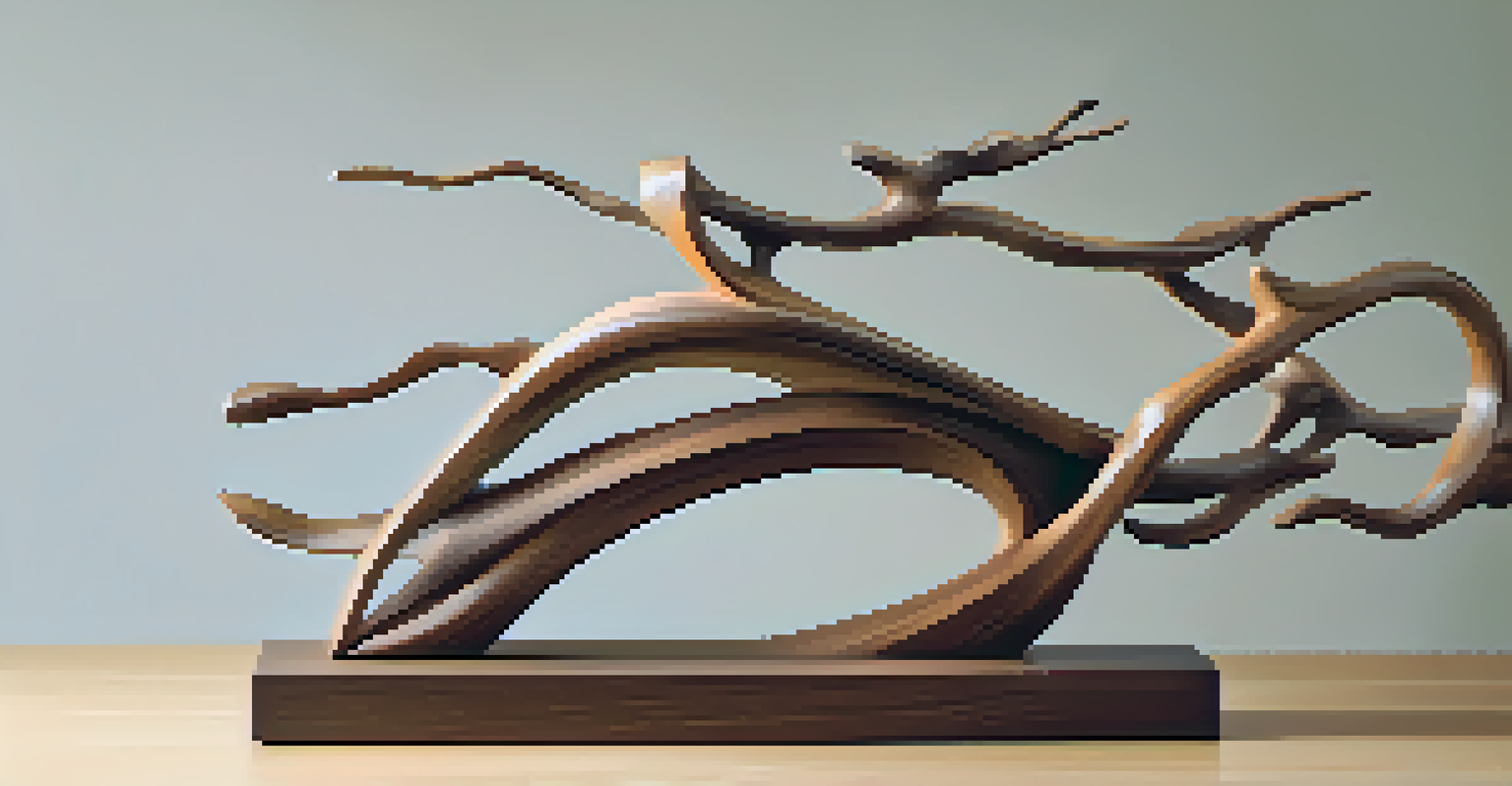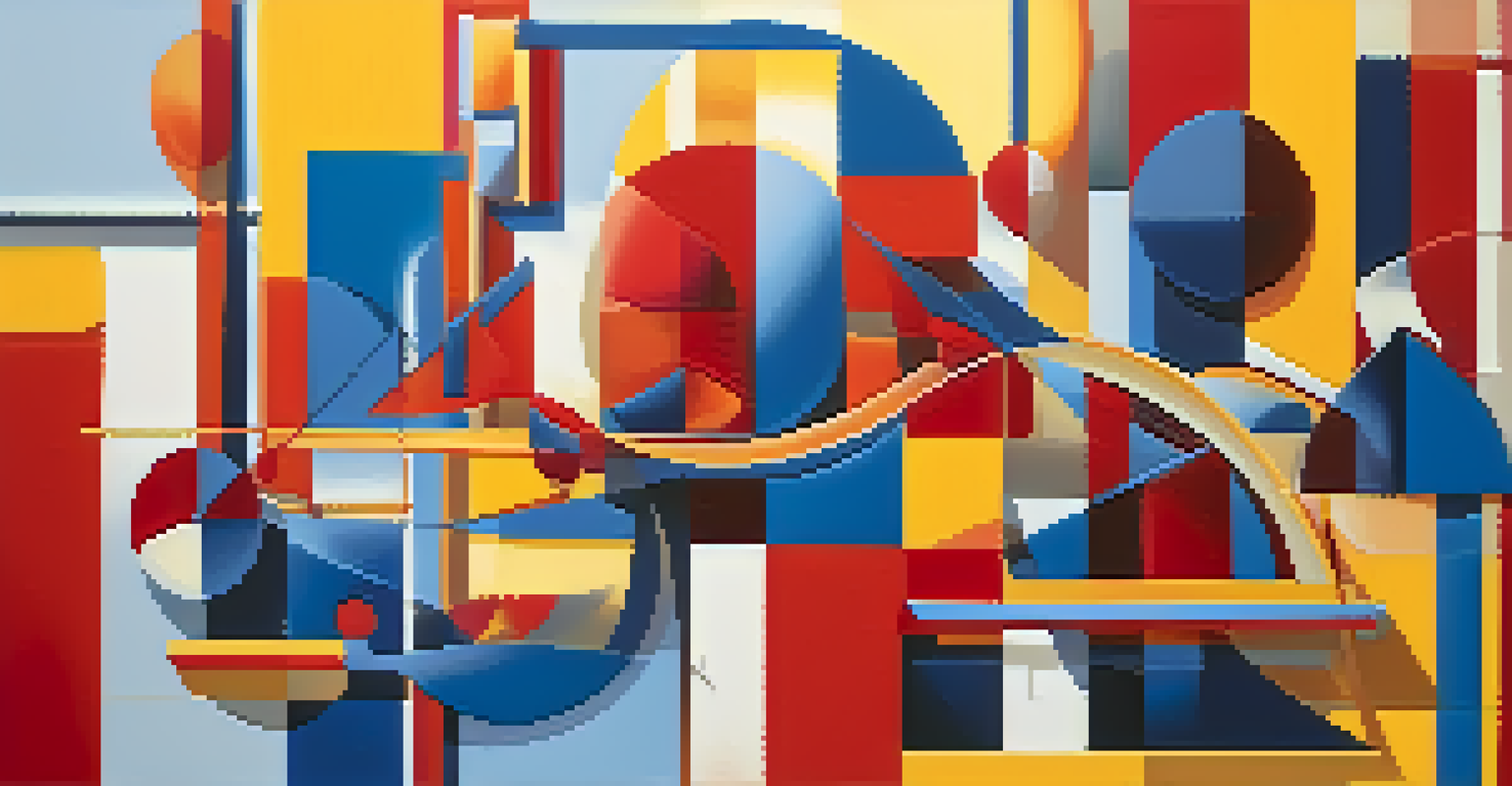The Psychology of Shape: Influencing Emotions in Carving

Understanding the Basics of Shape Psychology
Shape psychology is a fascinating field that explores how different shapes can influence human emotions and behaviors. From the angular lines of a square to the gentle curves of a circle, each shape carries its own emotional weight. For instance, circles often evoke feelings of warmth and comfort, while sharp angles might suggest tension or aggression. Recognizing these associations can help carvers choose shapes that align with the intended emotional message of their work.
Shapes are the language of the universe; they speak to us before we even understand the words.
Consider how a child's toy is often round and soft, making it inviting and safe. In contrast, consider a piece of modern furniture with sharp edges that may convey sophistication but can also feel unapproachable. This illustrates how the shapes we see shape our feelings and interactions with objects around us. Understanding these nuances is crucial for anyone looking to carve with intention.
Ultimately, the psychological impact of shapes serves as a powerful tool in carving. By harnessing the emotional resonance of different shapes, artisans can create pieces that not only captivate visually but also resonate deeply with viewers on an emotional level.
Emotional Responses to Geometric Shapes
Geometric shapes play a significant role in how we perceive and react to carved objects. For example, squares and rectangles are often associated with stability and reliability, making them popular in designs aimed at conveying trust. This is why you’ll often find these shapes in corporate logos and architecture, where a sense of security is paramount.

On the other hand, triangles can evoke feelings of action or tension, often used in designs that aim to inspire movement or a sense of urgency. Think about the use of triangular shapes in warning signs; they grab attention and convey a message quickly. Carvers can tap into these associations to guide the viewer's emotional journey through their artwork.
Shapes Influence Emotions
Different shapes evoke specific emotional responses, allowing artists to convey intended messages through their carvings.
By consciously selecting geometric shapes, artists can create an emotional landscape that enhances the overall experience of their carved pieces. Whether aiming for calmness, energy, or strength, understanding these emotional responses can elevate the impact of their work.
The Role of Organic Shapes in Carving
Organic shapes, characterized by their flowing lines and natural forms, are often more relatable and comforting compared to geometric shapes. Think about the soft curves of a leaf or the gentle undulations of a river; these shapes can evoke feelings of peace and tranquility. Carvers who incorporate organic shapes into their work often find that they create a sense of connection with nature, leading to a more profound emotional response from their audience.
Every shape has a story to tell; it’s up to us to listen and interpret its meaning.
For example, a carved piece that mimics the shape of a wave can evoke feelings of calmness and serenity, inviting viewers to reflect on their own experiences with nature. This connection can be particularly powerful in art pieces meant to inspire relaxation or mindfulness. Carving with organic shapes can also enhance the tactile experience, making the piece feel more inviting to touch.
Thus, when artists choose to carve organic shapes, they are not just creating visually appealing pieces; they are crafting emotional experiences that resonate with viewers on a deeper level, fostering a sense of harmony and connection.
Color and Shape: A Dynamic Duo in Carving
While shape plays a central role in influencing emotions, color is another critical factor that can amplify or alter those feelings. The combination of color and shape can create a more complex emotional narrative within a carved piece. For example, a bright red circle may evoke excitement and passion, while a blue square could suggest calm and stability. Understanding this interplay can help carvers design works that convey complex emotions effectively.
Consider how a piece carved in dark, angular shapes with a vibrant color palette might evoke feelings of energy mixed with unease. Alternatively, soft, pastel colors applied to rounded shapes can create a sense of comfort and joy. By strategically choosing both shape and color, carvers can craft a more nuanced emotional experience for their audience.
Color Enhances Shape Impact
The interplay between color and shape creates a richer emotional narrative, allowing carvers to deepen viewer engagement.
Ultimately, the synergy between color and shape is invaluable in carving. Artists who leverage this relationship can create pieces that not only attract the eye but also resonate emotionally, leaving a lasting impression on viewers.
Cultural Influences on Shape Perception
Cultural background plays a significant role in how shapes are perceived and the emotions they evoke. For instance, in some cultures, circular shapes may symbolize unity and wholeness, while in others, they might represent cycles of life and death. Understanding these cultural nuances can be crucial for carvers who want their work to resonate with diverse audiences.
Take the example of traditional Japanese art, where natural forms and asymmetry are celebrated. Carved pieces that embody these principles often evoke feelings of harmony and balance, reflecting the culture's deep connection to nature. In contrast, Western designs might lean towards symmetry and geometric shapes, emphasizing order and structure.
By being aware of these cultural influences, artists can create carvings that not only appeal visually but also resonate on an emotional level with specific audiences, fostering a deeper connection through their art.
The Impact of Shape on Storytelling in Carving
Shapes can serve as powerful storytelling tools in carving, conveying narratives without the need for words. Each shape can represent different themes or emotions, allowing the artist to craft a story that resonates with the viewer. For example, a twisted branch shape might symbolize struggle or transformation, while a smooth, flowing shape could tell a story of peace and harmony.
This storytelling aspect is particularly evident in cultural carvings, where specific shapes hold symbolic meanings that enrich the narrative. An artist might use a spiral shape to represent growth and evolution, inviting viewers to engage with the deeper message behind the artwork. In this way, shapes become a language of their own, telling stories that transcend verbal communication.
Cultural Context Matters
Cultural perceptions of shapes can vary significantly, affecting how carved pieces resonate with diverse audiences.
Thus, understanding the role of shape in storytelling can empower carvers to create more meaningful pieces. By thoughtfully integrating shape into their narrative, artists can invite viewers on a journey that evokes emotions and sparks reflection.
Conclusion: Harnessing Shape for Emotional Impact
In conclusion, the psychology of shape is a powerful element in carving that can significantly influence emotions and perceptions. By understanding the emotional associations linked to various shapes, artists can craft pieces that resonate deeply with viewers. Whether opting for geometric precision or organic fluidity, each choice communicates a message that can evoke specific feelings.
Moreover, the interplay of shape with color, cultural context, and storytelling enriches the emotional landscape of carved art. As artists explore these dimensions, they can create works that not only captivate the eye but also touch the heart, making their art more impactful.

Ultimately, harnessing the psychology of shape allows carvers to create pieces that foster connections and evoke emotions, transforming simple carvings into profound experiences.